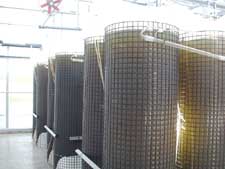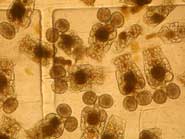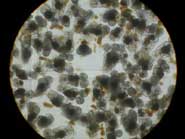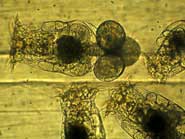Continuous Algal Production Systems
 How
do you grow algae in your hatchery? How
do you grow algae in your hatchery?
If you answer 'Yes' to any of these questions you need to
click here for help!
Are you still using a batch system, with all the time-consuming
repetitive work which this involves, or struggling to maintain
sterile conditions economically using filters?
Is output limited by algae production, which you cannot expand
for reasons of manpower, space and cost?
Do you have several people working nearly full-time on the
phytoplankton, upon which your production depends, whose holidays
or sick-leave bring you close to crisis?
Are half your algal cultures unready to be harvested at any
one time?
Do you spend a small fortune on heating then pour large quantities
of warmed water down the drain?
Do your cultures vary widely in quality, from the time when
you can start cropping them until the moment they have to
be dumped?
And do they sometimes fail just when you need them most?
View case
studies >>>
Rotifer Production
 Seasalter
Shellfish continuous algae systems used all over the world,
mainly by shellfish hatcheries, have seen some new applications
recently with the introduction of rotifer culture. (Species
illustrated Brachionus plicatillis). Seasalter
Shellfish continuous algae systems used all over the world,
mainly by shellfish hatcheries, have seen some new applications
recently with the introduction of rotifer culture. (Species
illustrated Brachionus plicatillis).
Rotifers are cultivated in an open flow system. In fact the
flow is just neat algae culture. As the algae system uses
only pasteurized water the rotifer cultures are free of any
harmful contamination such as vibrios, viruses or ciliates.
A typical rotifer culture will reach a density of 1500 to
2000 rotifers per ml. Everyday 50% of the volume of the culture
can be harvested. The following day as the culture has reach
its overflow level, the density is back to its normal level
and the process can be repeated indefinitely.
With the shortage of Artemia availability worldwide, high
quality algae and rotifer production seems to be the obvious
answer.
 Fish
fry need for their development a diet rich in polyunsaturated
fatty acids (PUFA) such as: Fish
fry need for their development a diet rich in polyunsaturated
fatty acids (PUFA) such as:
AA (arachidonic acid) 20:4(n-6)
EPA (eicosapentaenoic acid) 20:5(n-3)
DHA (docosahexaenoic acid) 22:6(n-3)
These essential fatty acids (EFA) cannot be synthesized de
novo by the fish but are naturally present in the algae species
grown in the bags system like Chaetoceros, Isochrisis, Pavlova
or Tetraselmis.
But what is crucial for good development and the survival
of the fry is not just the presence of these PUFA but their
ratio between one and other.
 By
its flexibility the bag system allow you to grow as many different
species as you have bags in your system if you whish to do
so. By
its flexibility the bag system allow you to grow as many different
species as you have bags in your system if you whish to do
so.
It then very easy once you now the EFA composition of the
different algae species to arrange a balanced diet close to
the required ratio of PUFA you are looking for.
This very simple yet very clever way of growing rotifers
will help you to get away from yeast and other food enrichment
additives that usually leads to poor quality live food.
Soon a new Cod farm situated in Norway will also be able
to benefit from the quality rotifers produced with the help
of a Seacaps continuous algae system. Each system supplied
comes with full staff training and full back up.
|